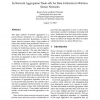Free Online Productivity Tools
i2Speak
i2Symbol
i2OCR
iTex2Img
iWeb2Print
iWeb2Shot
i2Type
iPdf2Split
iPdf2Merge
i2Bopomofo
i2Arabic
i2Style
i2Image
i2PDF
iLatex2Rtf
Sci2ools
IJSNET
2006
2006
In-network aggregation trade-offs for data collection in wireless sensor networks
This paper explores in-network aggregation as a power-efficient mechanism for collecting data in wireless sensor networks. In particular, we focus on sensor network scenarios where a large number of nodes nodes produce data periodically which is consumed by a sink node. Such communication model is typical of monitoring scenarios, one key application of sensor networks. The main idea behind innetwork aggregation is that, rather than sending individual data items from sensors to sinks, multiple data items are aggregated as they are forwarded by the sensor network. Through simulations, we evaluate the performance of different in-network aggregation algorithms in terms of the trade-offs between energy efficiency, data accuracy and freshness. Our results show that timing, i.e., how long a node waits to receive data from its children (downstream nodes in respect to the information sink) before forwarding data onto the next hop (toward the sink) plays a crucial role in the performance of agg...
Related Content
| Added | 13 Dec 2010 |
| Updated | 13 Dec 2010 |
| Type | Journal |
| Year | 2006 |
| Where | IJSNET |
| Authors | Ignacio Solis, Katia Obraczka |
Comments (0)

